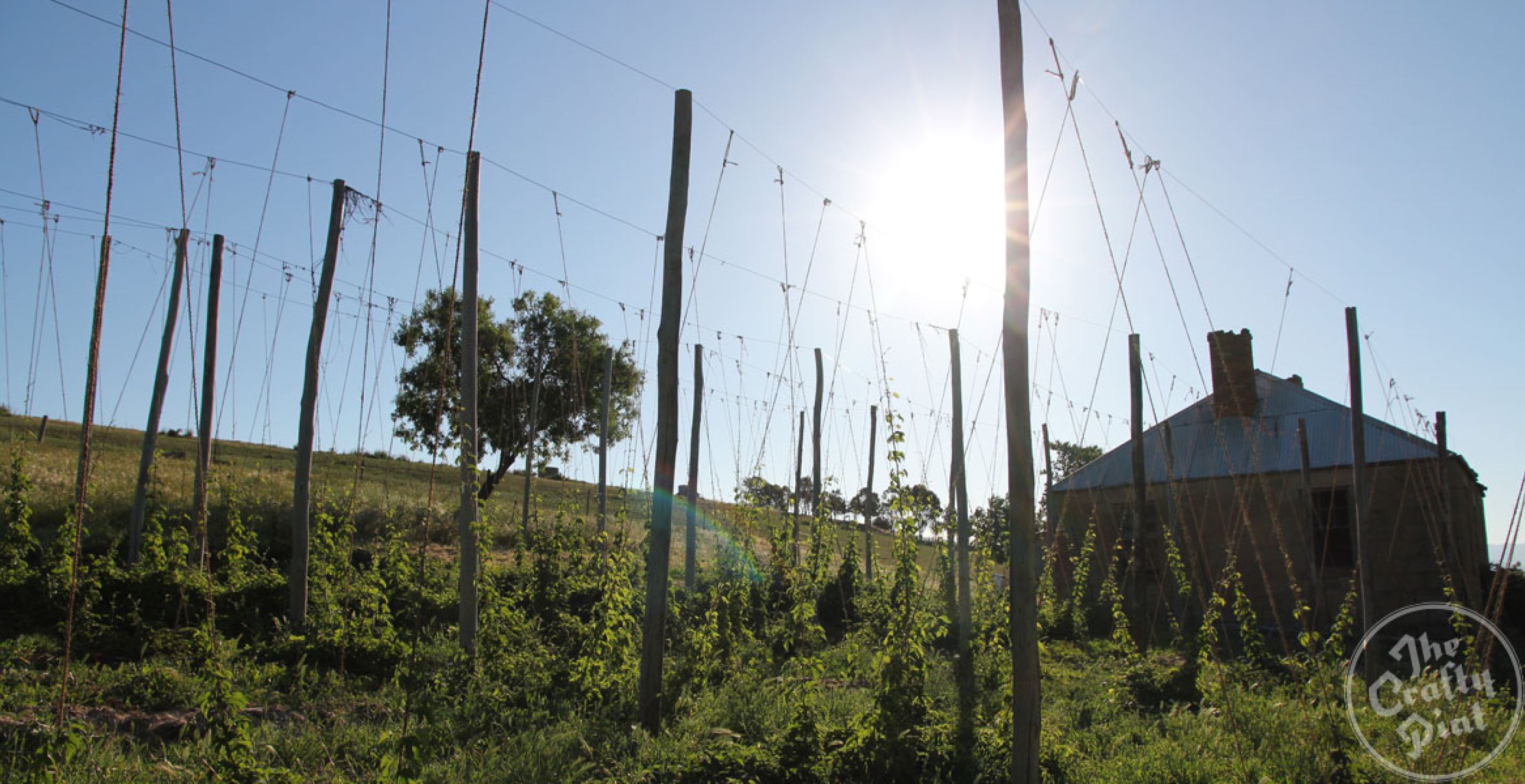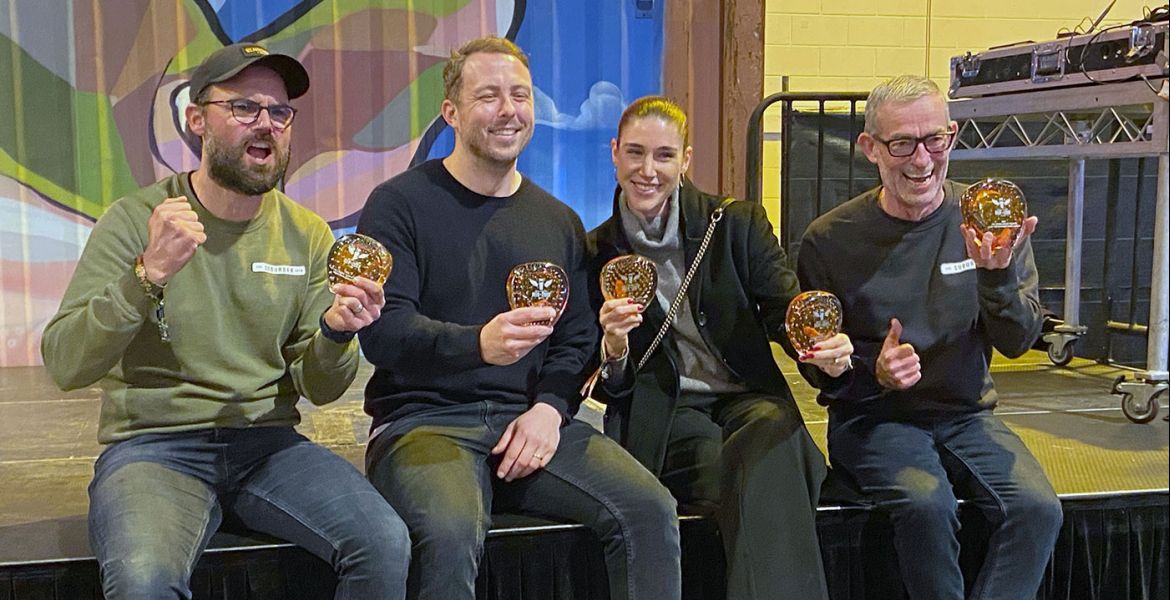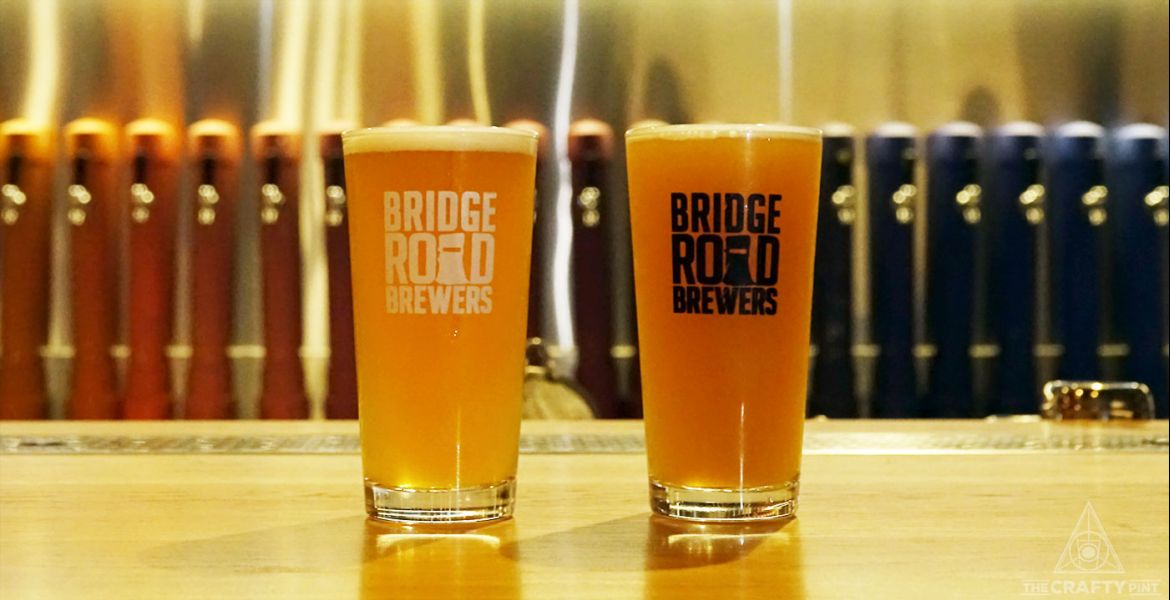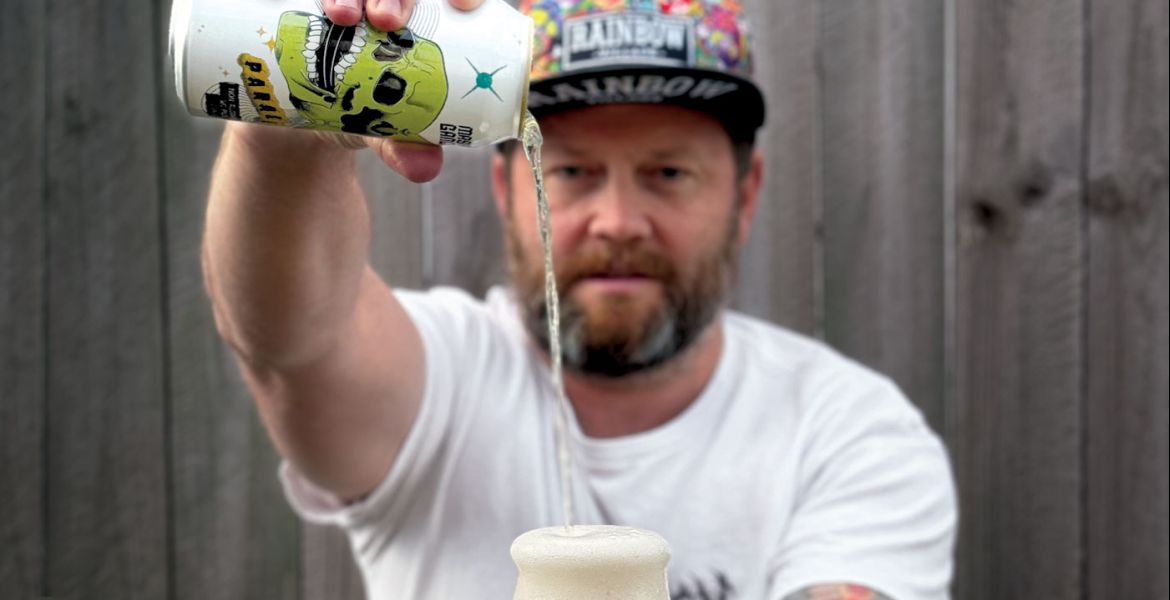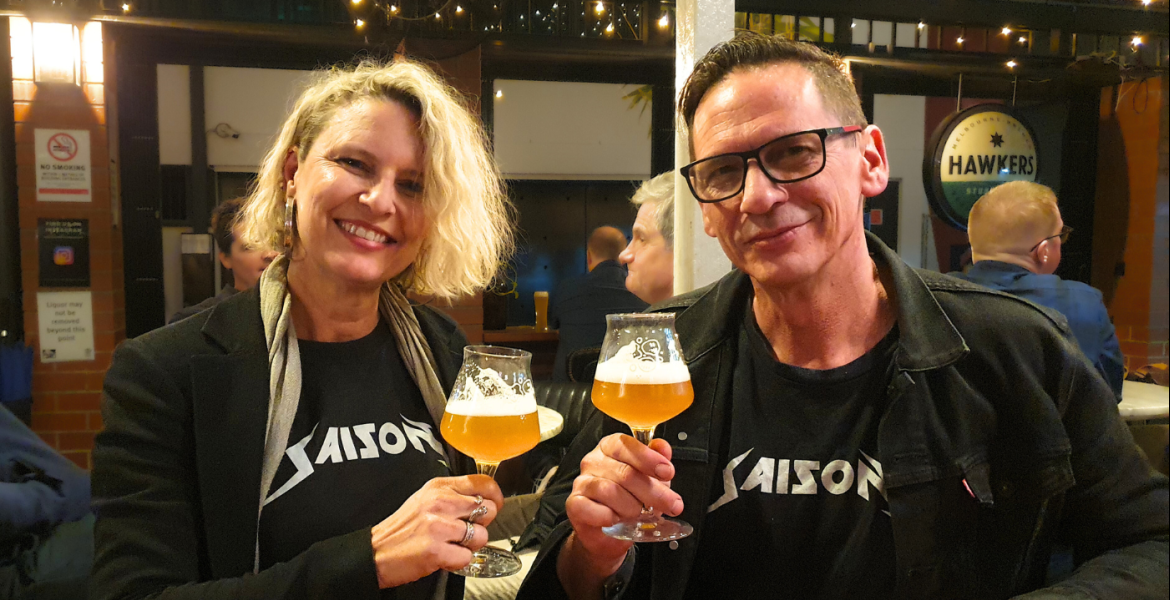A little over a decade ago, Ashley and Jane Huntington returned to Australia from France, where they had been operating La Baume, a small winery owned by Hardy’s. Upon returning, they bought several hundred acres of farmland running alongside the River Derwent in Tasmania with winemaking, once more, in mind.
There was a particular hill side on their newly acquired land that Ashley believed was “the most remarkable site in Tasmania to grow grapes”. Yet, when it came to starting their new business, they forsook grapes and instead began playing with grain.
From day one, Two Metre Tall set out to produce “farmhouse ale and cider”, specifically with a mission to develop a genuine estate ale: one using local river water, grain and hops grown on the site and fermented with whatever yeasts and bacteria call that part of Tasmania home.
“We used to cold soak the pinot noir grapes [when winemaking in France] to extract tannins and colour from the skin. So I thought as brewing was a hot process I would hot soak the spelt and drag some shit out of the husks,” recalls Ashley (pictured below right) of one of his earliest brews.
“I came back the next morning, having left the brewery feeling very satisfied, and thought, ‘What the fuck has happened?’ I now have a full and open explanation for it, but nine years ago I was disturbed.”
The cause of his disturbed state was that the liquid had started doing things he hadn’t expected and was displaying all manner of odd, unpleasant and funky characteristics. But, rather than pick up a brewing manual (which would have told him not to hot soak the grain in the first place) to see how to fix the issue, it got him thinking.
“Instead of going back to the shed and hiding, I thought, ‘That’s remarkably unpleasant. But it’s also acidic. So what happened there? The unpleasant stuff is unpleasant but the acidity…’
“As a winemaker I started thinking, ‘How can I use this?’”

Thus he continued ploughing his unique furrow, allowing yeasts and bacteria into his beers and cider in a manner that, certainly back then, was almost entirely unheard of in Australia. Beers bearing the same name would fluctuate greatly from batch to batch, and came with labels that were pretty much novellas explaining what was in the bottle, and why and when ingredients had been sourced.
What’s more, beers would also “fluctuate” while in the bottle as some of the more esoteric ingredients would go to work turning them, in some cases, sour.
Not only was this something retailers and drinkers weren’t expecting, it was something for the most part they explicitly didn’t want or understand. As such, pallets of beer would be returned with a side serving of anger.
Word was spread – frequently by his brewing peers – that Two Metre Tall’s beers were awful and, worse still, that Ashley posed a grave danger to the hopes of those looking to build an Australian craft beer industry.
It hurt. In fact, it hurt a lot and, the best part of a decade later, the scars from these attacks still show. Yet, just as the “remarkably unpleasant” outcomes of his first brew didn’t put him off, his fascination and, presumably, his determination, grew.
“I was addictively fascinated as to what was happening – with how [the brewing] was operating and also that I’d been so dismissed,” he says.
“‘Not only are we going to run from the room screaming, we are going to tell everyone how bad it was in the loudest possible yell, with the message “Let’s kill him!”’ he says of the vitriol he faced.
“That fascinated me as well. I found myself the subject of the mob. Why was it upsetting them so much?”
Thus, back in Tasmania, Ashley continued trying to work out how to use the quirks in his beers to create remarkably pleasant beers and also beer that would genuinely be a representation of his farm; hops were planted and brewing tanks were retrofitted to add expansion chambers, thus making them more atmospheric and even further from the aseptic breweries the manuals would insist upon.
At the same time, across Australia, the reputation of Two Metre Tall as a producer of wildly inconsistent beers and Ashley as a brewer who didn’t have a clue what he was doing continued to grow. Yet, so did sales of his beers; as he points out, he and Jane have survived off nothing other than selling their beer and cider since his first brew.
It was with that knowledge in mind – that Two Metre Tall was something of a joke brewery making funky beers you couldn’t drink – that The Crafty Pint first visited several years ago. As we pulled our hire car into the farm car park, there was consolation at least that the drive along the Derwent Valley had been beautiful and, even if the beers and ciders were awful, it was a great day to be out in the country.
Then we met Ashley and Jane. He pulled a Derwent Ale from behind the bar, explaining that it was from a pallet that had been sent back from Melbourne as it was “off”. What he poured was a crystal clear, fruity and acidic drink that, while not what the retailer who had returned it had expected, was delicious.
“It’s been getting better the older it gets,” said Ashley before leading a tour of his brewery and explaining his ethos – at least as far as he’d worked it out to that point. Later, we enjoyed a glass of a just tapped Soured Ale from one of the container bar’s hand pumps. This was an early iteration of what will ultimately become that estate ale (of which more later) and was, very possibly, the most delightful beer of all sampled on that Tasmanian tour. It was unlike anything else too: intriguing and quite wonderful.
The visit also taught us why the brewery was so called: Ashley is a very tall man. And, although we only got a glimpse of it then, the height and the stubborn curiosity driving him down this seemingly futile road weren’t his most striking qualities. Here was possibly the most fascinating, multifaceted, passionate and, let’s face it, lunatic person in the entire Australian beer world.
We drove back to Hobart perplexed.

Jump forward a little to 2013. Ashley’s understanding of what’s going on with his beers and ciders is developing apace. He’s embraced the batch variations, thriving upon the vintage like nature of his beers. For the most part, Two Metre Tall remains a weird oddity on the fringes of the beer world but, with interest in sours and farmhouse ales growing, there is a band of aficionados getting excited about what’s happening on his farm.
Yet all is not well in the Derwent Valley.
“I was at death’s door,” he says. “I’d been doing what I was doing for six years and was getting nowhere.”
Rather than give up, however, he applied for a Churchill Fellowship, hoping to secure funds to travel through Europe and the USA visiting, for the most part, brewers of sour, wild or farmhouse ales.
“It was my last gasp. I thought, ‘Surely I’m not the only person doing this.’
“I'd heard about lambics but didn’t know much about them. So I went to see if there was anything in it.”
And there was. Over six weeks of “breakfast, visit breweries, lunch, visit breweries, then a fucking great dinner”, some with Jane and their girls in tow, some travelling solo, he met people doing similar things to him. A few had been doing it for decades, others were just starting out. But the main point was clear: they were doing it. Maybe he wasn’t completely nuts after all.
“It was a rebirth,” he says. “It gave me a language to refer to. At that point I’d been slogging away for years into a very stiff breeze. You pursue something and travel in the field of your own interest. Then you’re removed from what you’re doing and it’s a renewal and inspiration and reassessment – especially when you’re stuck in a field out here and the cows start looking attractive…
“It was an extraordinary transformation on every level.”
It was transformative in that it offered reassurance that he wasn’t alone. Transformative in the sense that he could return to Tasmania newly inspired to continue. And transformative in that it gave him a broader understanding not only of where Two Metre Tall stood within the evolving global beer landscape but also of how that global landscape looked.
Visits to some iconic Belgian breweries taught him that even there commercial interests were changing processes, that bureaucratic decisions sometimes hurt smaller brewers, and that oft told stories didn’t always bear close scrutiny.
“I spent a day driving to Orval and back again and I recommend not to bother. It’s bullshit that the monks are making the beer,” he says.
On another day, he discovered on a visit to a famous bottleshop in which different regions of the world had walls of beer dedicated to them that the owners had seen the need to stock just three Aussies: VB, James Boags and Coopers.
“I snuck from the store in case anyone heard my accent,” he recalls.
Meanwhile, many of the new wave of brewers producing sour or farmhouse ales, to his mind, weren’t really doing it as he understood it, as they were pitching “wild” yeasts they’d bought in packets into sealed tanks where they could control what the yeasts would do. And, highlighted by the beers sampled at the final brewery of his trip, The Bruery in California, he came to suspect that some of these brewers were engaged in an arms race to produce the most extreme sour beers they could – “replacing the word hop with the word sour and just trying to overdo it all”. Surely, he thought, the goal should be balance.
Yet, despite the barrage of often conflicting new knowledge bombarding his brain, he landed in Sydney “panting with enthusiasm”.
“The trip didn’t change a thing I was doing but all of a sudden I had context for it,” he says. “I was able to alter my stance from both feet side-by-side to one foot in front of the other. I was able to face the market.
“By the time I got back to my pile of steaming poo in Tasmania, I was starting to gain some real perspective and richness. We had been doing [what we were doing] for long enough that if it was a problem then I’d had ample time and opportunity to fix it. And I hadn’t. In fact, it got worse. I was modifying tanks from being very decent brewing tanks to being tanks that did what I wanted to do here. I persisted in doing what I was doing and forging ahead but without any frame of reference or language.”
Finally, he had that frame of reference, coupled with renewed enthusiasm to further develop his philosophy. It’s one that runs counter to that of the vast majority of brewers yet is shared by others, like Texans Jester King, whose beers are some of the most sought after on the planet.
“The Great Wall of China is constructed between the style of brewing that says, ‘My goal is based around the pitching of this particular organism and my desire to express its characteristics in the company of the ingredients I have put together. Therefore I must exclude everything else.’
“On the other side of the coin is the one that says, ‘I don’t have this packet of organisms that I want to express but I have these ingredients and this site and this situation and I want it to tell its own story through the beverage.’
“They are absolutely, completely different skill sets and concepts.”

His time in America has helped open other avenues. While there, Ashley and his approach came to the notice of specialist importer / distributor, the Shelton Brothers. They have since signed him to their roster and are to import his beers to the US, at least once the Cleansing Ale is rebranded as Tasmanian Wild Ale after the FDA claimed its original name suggested potential health benefits.
Considering that, outside the big boys, only Mountain Goat for a short time and Bridge Road, due in part to its position as the premier exponent of the new Aussie hop varieties that are exciting American brewers and drinkers, have sparked any interest there, this is some achievement.
“The Shelton Bros are specifically interested in the field that we are in,” says Ashley. “The company [we are in with them] is pretty embarrassing from my perspective. We are dealing with some extraordinary brewers but, by and large, that was part of the fascination of mine – to know that I wasn’t making this all up as I go along.
“They see a real positive in our story and that I’m not relying on pitching cultures. They see this farm and this brewery just making this beer. It’s what historically beer has always been.
“You take all the beer consumed by mankind across history and this little chapter of negativity I’ve been through looks better because it carries the historical weight of the vast majority of that journey.”
The history of beer in Australia as a totality is only a tiny part of that journey. Yet the past few years have been a period of incredible change for the industry as a whole in Australia, perhaps the most remarkable yet. And, as our recent article on the Tasmanian Beer Trail highlighted, that’s as true of Tasmania as anywhere, with the number of brewing companies doubling in just a couple of years.
“We [recently] emerged from the Dark Mofo festival,” says Ashley. “We came [to Tasmania] 11 years ago and people used to run and hide in April and didn’t come out until September, but this has just flicked that on its head.
“It’s wrenching people out of their little holes, smacking them round the chops and saying, ‘Have fun!’ And they are.”
Ashley, Jane and team were among those leaving their little holes for the festival, where among the beers they were pouring was a seven-year-old Cleansing Ale. He only has such a beer to pour because he couldn’t sell it when initially brewed yet believes that batch is still developing and improving.
“I didn’t mean to still have it now [when I brewed it], I just don’t throw beer away,” he says.
It’s a policy that has helped his philosophy develop as he’s been able to watch beers evolve not just from batch to batch but individual batches from year to year too.
“They are not faults, they are steps towards getting to where I had to be,” he says of the beers he’s brewed over the past nine years. “I wasn't being led there, I couldn’t refer to any books or universities to get me there. Each step that I took was a step in the wrong direction, a step towards isolation for years.
“Then we got to Belgium and the US and met brewer after brewer after brewer and – I get emotional about it even now – there was such a phenomenal feeling of engagement. If I genuinely believed it was wrong I wouldn’t have kept doing it. But to get to the other side of the world and discover [I wasn’t] was nice.”
You might think this newfound faith in his practices would have led to a solidifying of what his beers – the likes of the Cleansing Ale, Derwent Ale, Forester and Huon Dark Ale – represent. Yet, when asked about the Two Metre Tall “core range”, the idiosyncratic approach that drives him comes quickly to the surface again.
“It’s like a flapping hose,” he says. “And I know that’s very controversial.
“One of the most distinct criticisms I’ve had to face is that we didn’t mean this to happen. ‘You can’t repeat this. You’re not in control. You don’t know what you’re doing. You’re not driving mastery of your process.’
“Yet that’s exactly the mind frame you need to be in to do [what I’m doing] properly. So here is my middle finger to that concept [of consistent core beers]. Had I been brewing monoculture, sterile beers I wouldn’t be brewing now. It wouldn’t have sustained my interest in the subject for so long.”

Soon, brewing farmhouse ales and ciders in the Derwent Valley will have sustained his interest for a decade. Yet the estate beer he set out to brew at the start remains at 75 percent completion. The missing element is estate malted barley, although it’s coming. Having decided against planting vines on his dream slope, he’s been growing grains there since 2004 instead.
The issue will be turning it to malt, with the maltings at Cascade in Hobart now closed down and most commercial options requiring minimum batch sizes far greater than he grows each year.
“Every winter I say I’m going to [build my own maltings]. And now, quite frankly, I need to as the options are drying up in Tasmania. Once SABMiller bought Cascade, I knew it was only a matter of time that the maltings would be gone. And that happened. So I have to do it to complete my project if for no other reason.”
While in the US, he visited small scale “garage” maltsters upon whose techniques he is likely to base his own. And, having overcome obstacles that would have scuppered many others – frequently self-inflicted then worsened by rubbing acid into the wounds – one wouldn’t bet against it happening.
Our first encounter with Ashley post Fellowship wasn’t at his farm but a dinner at which he was starring at Sydney’s excellent Cammeray Craft (pictured above). In front of an audience of 30 or so in the restaurant, his newfound zeal shone through.
With thick, curly locks a few inches longer than the last time we’d met adding to his wild man aesthetic, he prowled the room, flinging his arms out to what appeared to be a four metre wingspan as he discussed the beers and his journey. He discussed much more besides: the erosion of genuine, small scale, traditional farming – something he highlights through his beers and ciders by supporting the survivors; the insidious nature of the dominance of the major retailers. And he did so in such a way that, like Midwestern farmers faced with a powerfully oratorial preacher in 19th century America, those in attendance had little option but to wilt to his passionately espoused theories.
This reignited drive hadn’t erased his eccentricity, however, as evidenced by a moment towards the end of the dinner. The course was due to be served with his Dark Huon Ale and the drink that was poured into the glasses on our table was indeed dark. But, while it had been some time since we’d last sampled the Huon, even taking into account Ashley’s declared variability this was way off what we’d been expecting. So we offered him our glass.
“Hmmm…” he said after taking a few sniffs. “Hmmm…”
Then a sip and the light went on.
“Ah! I know what this is. It’s a sour cherry wine I made using cherries from a local orchard [another whose plight he was hoping to highlight]. I asked Jane to pack the beers for the dinner and forgot to tell her I’d put it in bottles marked as something else. Isn’t it delicious, though?”
It was. And, what’s more, given it had been a tiny experimental batch, the entirety of his creation was now in the glasses of some of the guests at the dinner rather than back at the ranch in Tasmania to be studied.
Despite such comical pratfalls, the original goal of an estate ale moves ever closer to completion. And, with interest in Two Metre Tall’s unique expressions of the land through beer and cider spreading internationally (award-winning London beer writer Will Hawkes was keen to pick our brains about Two Metre Tall when in Melbourne for Good Beer Week), that “remarkably unpleasant” early brew must feel like it was a lifetime ago.
“Isn’t it fascinating: the passage of time and how things evolve?” he says.
“In its unfettered ignorance, [that attempt at making beer] is just wonderful because I have developed so many of my brain processes from that. Yet I still cringe at that same bloke: ‘me’.
“I look back and think, ‘You fucking idiot!’ But if it didn’t happen, this wouldn’t have happened.”
And the Australian beer world would be far less colourful for it.
Two Metre Tall beers are starting to crop up at more outlets across Australia. Their Farm Bar is open on Sundays from 12pm to 5pm.
The black and white photo of Ashley at the top of the article is by The Beer Drinkers. You can check out their post on Two Metre Tall here.




